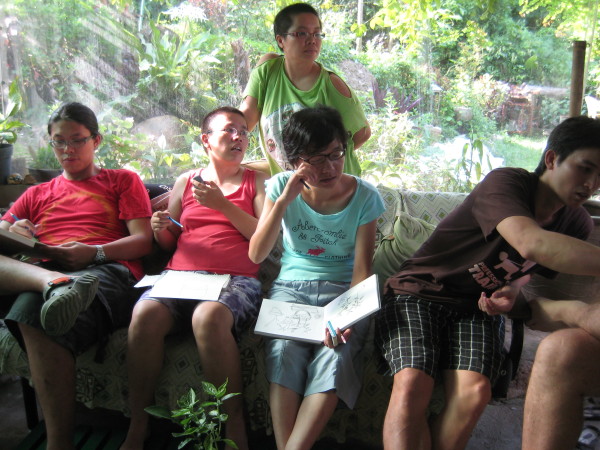A reader’s Letter to the Editor appeared in the South China Morning Post by Ben, Lok Pan Tsang, of Yuen Long in the New Territories where he refers to a report titled “A question of characters”, published August 18, 2014 in the same newspaper. The issue raised was that of using Putonghua as medium of instruction for Chinese language in schools. “Cantonese is the language that the majority of Hongkongers speak. Because of that it should continue to be the medium of instruction for Chinese language.
Ben Tsang is a secondary school student who will sit for the Hong Kong Diploma for Secondary Education (HKDSE) examination in a few years, he wrote the letter to express his concern over a recent trend that Putonghua becomes more widely taught from kindergartens to secondary schools in the city.
Ben says that it is understandable that learning to speak Putonghua fluently can, to a certain extent, create more future prospects in mainland China, where the economy is booming since the nation’s economic reform in 1978, particularly after China’s resumption of Hong Kong’s sovereignty in 1997.
However, as he mentioned in the letter (reproduced below), Cantonese, as one of the closest surviving dialect to ancient Chinese, can enhance our learning of Chinese classics not only because the majority of Hongkongers get used to speak Cantonese as their primary language, but also because of Cantonese’s long history, which enables Cantonese to be the preferred language of learning classical literature like poetry. This will definitely help preserve the heritage of the classical literature and culture of China, as well as Cantonese itself.
In terms of prospects, Ben Tsang continues, “as Chinese classics are examined in the Chinese reading paper of HKDSE examination, it is hope that through learning the classics more authentically and fluently with Cantonese, students will have a better result in the paper, where students generally have poor results, which could crucially affect the opportunity to be promoted to universities in the city.”
The letter:
“Research has shown that Cantonese is in fact a blend of ancient Chinese, which can be traced back to the Tang dynasty, and the dialects of the Lingnan region of southern China. It is the closest surviving dialect to ancient Chinese.
“Cantonese is always regarded as a preferred language in reading Chinese classical literature such as poetry, as almost all poetic devices for those classical poems, like rhythm and rhyme, remain. Those devices do not work well if a poem is read in Putonghua.
“The Chinese classics are widely taught in secondary education, and are examined in the reading paper of the Hong Kong Diploma of Secondary Education exam. Therefore, it is better to use Cantonese as the medium of instruction of Chinese language to let students learn these classics more authentically and fluently. They are also likely to get a better result in an exam that students have dubbed “the paper of death”.
The authorities in Guangzhou are now relegating the importance of Cantonese by using Putonghua rather than their native Cantonese in news reports by the regional TV station. Therefore, Hong Kong, as one of the few places where Cantonese is widely spoken, should have an awareness of the need to preserve the heritage of Cantonese in terms of literature and culture through education.
Ben Tsang adds even more depth to his case when he further notes that: “Some Chinese characters that are usually used in spoken Cantonese can be found in some Chinese classics of different dynasties with the same literal meaning, which can be traced back as early as the Western Zhou dynasty (1046–771 BC).
“In addition to that, during the governorship of Sir Cecil Clementi, a Sinologist who was advanced in Cantonese, Chinese literature and calligraphy (1925-1930), Chinese education was greatly advocated with the establishment of a Department of Chinese at the University of Hong Kong and the first Chinese secondary school (today’s Clementi Secondary School), where Chinese classics were taught by such intellectuals of late Qing period as Lai Chai-hei, and most importantly, the curriculum of Chinese language was conducted in Cantonese, making Hong Kong enriched with traditional Chinese culture, which was greatly criticised during the New Cultural Movement in China.”
Ben Tsang also pointed out that there has been further recent Letters to the Editor in the SCMP on the issue, namely:
HK students would rather use Cantonese
I refer to the report “Doubts raised about using Putonghua as medium or instruction for Chinese language”, (SCMP, August 17).
Generally, Hong Kong students feel more comfortable when talking in Cantonese, given that it is their mother tongue. When adolescents are talking to each other, they use Cantonese, not Putonghua. Some of them find it embarrassing in the classroom because they sometimes get the pronunciation of Putonghua wrong. This makes learning Chinese language more difficult.
In my experience, when a Chinese language teacher asks a question in Putonghua at junior form level, fewer pupils are willing to answer. Many do not feel comfortable with the language and they would be more reluctant to speak out in class and express their views if the medium of instruction was Putonghua. I do not believe that using Putonghua will help learners have a better understanding of Chinese language, or that they will acquire better reading and listening skills. It will not give them any advantage in the Diploma of Secondary Education exam. Of course it is useful to learn a second language, but not to use it as the medium of instruction. Youngsters may also find themselves getting confused by differences in pronunciation between Cantonese and Putonghua. Cantonese should continue to be used to teach Chinese language in Hong Kong’s schools.
There may be some students who would prefer to use Putonghua, but the vast majority will feel far more comfortable, and perform better, if schools stick with Cantonese.
Helen Chan Si-tung, Tseung Kwan O










